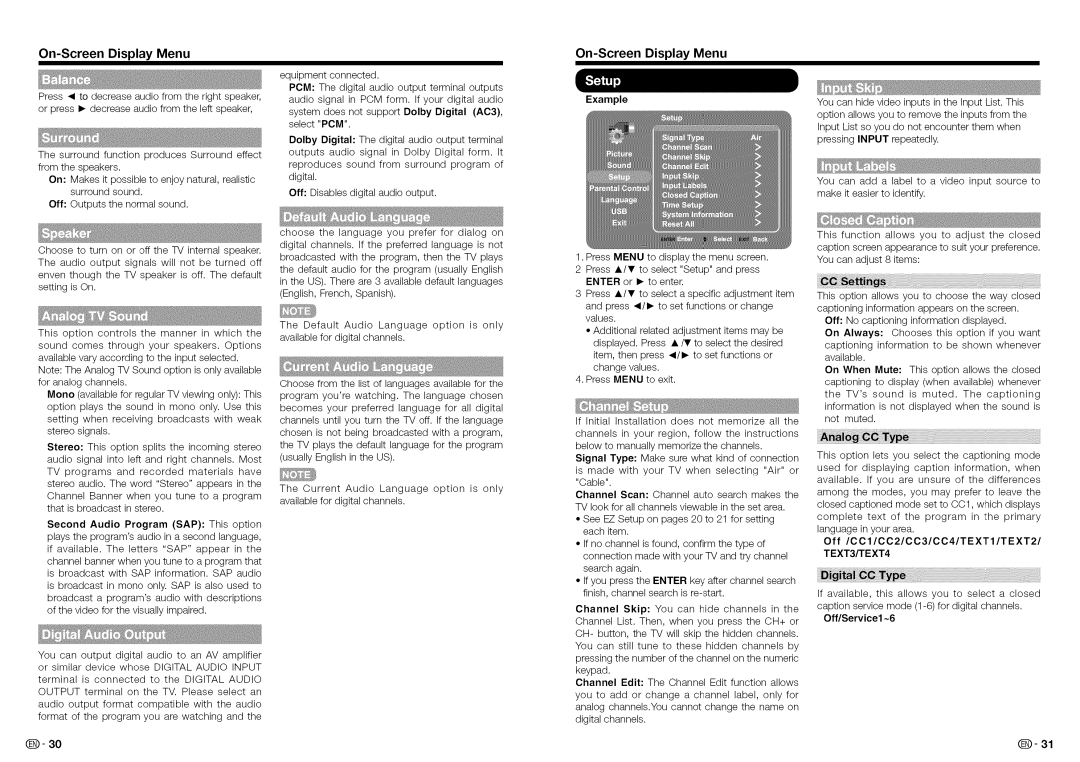
On-Screen Display Menu
equipment connected.
On-Screen Display Menu
Press • to decrease audio from the right speaker, or press I_ decrease audio from the left speaker,
The surround function produces Surround effect from the speakers.
On: Makes it possible to enjoy natural, realistic surround sound.
Off: Outputs the normal sound.
Choose to turn on or off the TV internal speaker. The audio output signals will not be turned off enven though the TV speaker is off. The default setting is On.
This option controls the manner in which the sound comes through your speakers. Options available vary according to the input selected.
Note: The Analog TV Sound option is only available for analog channels.
Mono (available for regular TV viewing only): This option plays the sound in mono only. Use this setting when receiving broadcasts with weak stereo signals.
Stereo: This option splits the incoming stereo audio signal into left and right channels. Most TV programs and recorded materials have stereo audio. The word "Stereo" appears in the
Channel Banner when you tune to a program that is broadcast in stereo.
Second Audio Program (SAP): This option plays the program's audio in a second language, if available. The letters "SAP" appear in the channel banner when you tune to a program that is broadcast with SAP information. SAP audio
is broadcast in mono only. SAP is also used to broadcast a program's audio with descriptions of the video for the visually impaired.
You can output digital audio to an AV amplifier or similar device whose DIGITAL AUDIO INPUT terminal is connected to the DIGITAL AUDIO OUTPUT terminal on the TV. Please select an
audio output format compatible with the audio format of the program you are watching and the
PCM: The digital audio output terminal outputs audio signal in PCM form. If your digital audio
system does not support Dolby Digital (AC3), select "PCM".
Dolby Digital: The digital audio output terminal outputs audio signal in Dolby Digital form. It reproduces sound from surround program of digital.
Off: Disables digital audio output.
choose the language you prefer for dialog on digital channels. If the preferred language is not broadcasted with the program, then the TV plays the default audio for the program (usually English in the US). There are 3 available default languages (English, French, Spanish).
The Default Audio Language option is only available for digital channels.
Choose from the list of languages available for the program you're watching. The language chosen becomes your preferred language for all digital channels until you turn the TV off. If the language chosen is not being broadcasted with a program, the TV plays the default language for the program (usually English in the US).
The Current Audio Language option is only available for digital channels.
Example
1.Press MENU to display the menu screen.
2 Press •/T to select "Setup" and press ENTER or I_ to enter.
3 Press •IT to select a specific adjustment item and press •liD, to set functions or change values.
•Additional related adjustment items may be displayed. Press •/T to select the desired item, then press •liD- to set functions or change values.
4.Press MENU to exit.
If Initial Installation does not memorize all the
channels in your region, follow the instructions below to manually memorize the channels.
Signal Type: Make sure what kind of connection is made with your TV when selecting "Air" or "Cable".
Channel Scan: Channel auto search makes the TV look for all channels viewable in the set area.
•See EZ Setup on pages 20 to 21 for setting each item.
•If no channel is found, confirm the type of connection made with your TV and try channel search again.
•If you press the ENTER key after channel search finish, channel search is
Channel Skip: You can hide channels in the Channel List. Then, when you press the OH+ or CH- button, the TV will skip the hidden channels. You can still tune to these hidden channels by pressing the number of the channel on the numeric
keypad.
Channel Edit: The Channel Edit function allows
you to add or change a channel label, only for analog channels.You cannot change the name on digital channels.
You can hide video inputs in the Input List. This option allows you to remove the inputs from the Input List so you do not encounter them when pressing INPUT repeatedly.
You can add a label to a video input source to make it easier to identify.
This function allows you to adjust the closed caption screen appearance to suit your preference. You can adjust 8 items:
This option allows you to choose the way closed captioning information appears on the screen.
Off: No captioning information displayed.
On Always: Chooses this option if you want
captioning information to be shown whenever available.
On When Mute: This option allows the closed captioning to display (when available) whenever the TV's sound is muted. The captioning information is not displayed when the sound is not muted.
This option lets you select the captioning mode used for displaying caption information, when available. If you are unsure of the differences among the modes, you may prefer to leave the closed captioned mode set to CC1, which displays complete text of the program in the primary language in your area.
Off /CC1/CC2/CC3/CC4/TEXT1/TEXT2/
TEXT3/TEXT4
If available, this allows you to select a closed caption service mode
Off/Service1 ~6
Q- 30 | Q- 31 |
